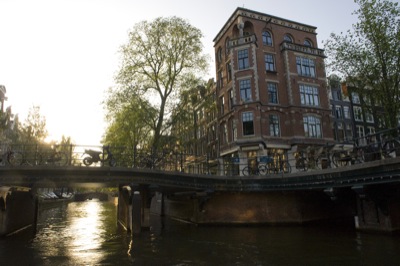
Courtesy I Amsterdam
In Amsterdam, it takes about three days to feel like a local.
Although many European capitals are large and complex, the Dutch city feels more like a charming hometown than a sprawling metropolis. With its iconic canals, corner cafes and outdoor flower markets, Amsterdam puts visitors at ease.
For groups, Amsterdam’s numerous world-class museums and historic landmarks give plenty of opportunities for traditional touring; its walkable streets and relaxed pace make it perfect for free time and exploration. Combine a little bit of both, and you have a wonderful European experience for your group.
I got to know Amsterdam during a summer trip as a guest of Monograms, an arm of the Globus family of brands that gives visitors independent tour experiences. Over the course of three days, I learned to eat like a local, traverse the city on foot and admire the best of Holland’s art and history. So, here’s my guide to three great days in Amsterdam.
Day One: Taste and See
During my visit, a city tour was included as part of the Monograms package. Leon Spit, the local guide in Amsterdam, gave us the lay of the land as we traveled the canals by boat.
“Amsterdam was built over a peat bog, and so the canals were created for only one reason: drainage,” he said. “Later, we started using them for transportation. Some of the canals are two feet below sea level, so 50 percent of the city would disappear without dikes and dunes here to protect us.”
Today, those canals are an essential part of Amsterdam’s allure. Some 165 canals crisscross through the heart of the city, spanned by 1,280 bridges. There are around 6,800 historic buildings in the city, built between the 16th and 18th centuries, and the facades of these beautiful structures reflect in the dark canal waters to create a one-of-a-kind streetscape.
The canals are also home to thousands of Amsterdam locals, who live in houseboats permanently moored along the banks. The houseboats all tap into the city’s sewer and utility services, and are one of the most in-demand types of housing in the city, with average prices climbing over 350,000 euros.
This first day is also a great opportunity to become familiar with one of Amsterdam’s most unusual treats: the Dutch pancake. Although we know pancakes as an American breakfast food, in Amsterdam and throughout the Netherlands, they are favorite dishes for lunch or dinner. There are dozens, perhaps hundreds, of pancake houses throughout the city serving locals and tourists alike; wherever you go, chances are you’re not far from one.
I ate pancakes several times during my visit to Amsterdam and found myself fascinated with the different varieties. Unlike the fluffy and sweet American pancake, Dutch pancakes are wide, thin and spongy, covering a dinner plate from rim to rim. You can have them plain, or order them with an endless variety of toppings and fillings. If you’re in the mood for dessert, try a pancake stuffed with chocolate, fruit or cream; if you’re feeling more adventurous, savory options, such as a banana-bacon-red pepper pancake, make for a delicious dining experience.
Day Two: Hidden History
From the outside, Otto Frank’s workshop looks nondescript, and that was the point: During World War II, Frank and his family hid from Nazi soldiers in a secret apartment above the workshop in an ordinary Amsterdam neighborhood. Frank’s daughter Anne detailed the affair in a diary that went on to become a worldwide best seller. Today, the plain-looking building is one of Amsterdam’s most important historic sites and an important stop for any visitor.
The Jewish family moved from Germany to Amsterdam to escape Adolph Hitler in 1940. But by 1942, the Nazis had taken over the Netherlands in a five-day blitz and had begun to round up Jews in Amsterdam and send them off to concentration camps. Four of Otto’s employees helped to conceal the Frank family and four other Jews in a secret apartment behind the warehouse and offices where Otto worked.
The Franks managed to stay sequestered for nearly two years, and Anne, then 15 years old, kept detailed diaries about the family’s time in hiding. Unfortunately, the “Secret Annex” was eventually found and the Franks sent off to Auschwitz. Of the eight people hidden in the house, only Otto survived the concentration camp.
Years later, after the diaries were published, Otto converted the former warehouse into a museum, now known as the Anne Frank House. Most days, it is packed with visitors. During my tour, I saw the small rooms where the refugees were forced to spend their days behind blackout curtains, fearing even to peer out the window onto the streets below. In video exhibits throughout the museum, friends and contemporaries of the Frank family tell their stories about Otto, Anne and surviving the Nazi regime.
At times, the stories at the Anne Frank House are difficult to hear. But they provide a deep and compelling look into some of Amsterdam’s most historic times.
Day Three: Art at the Heart
To really know Amsterdam, you must get to know its artwork. This city, and the Netherlands in general, have a centuries-old artistic tradition that is among the richest in the world. Several major art museums in town showcase the city’s most treasured works.
Begin with a visit to the Rijksmuseum, the largest and most important museum in the Netherlands. The museum exhibits the best of Dutch art, especially pieces from the Dutch Golden Age of the 17th century. Much of the space is currently closed for a massive renovation project that will last until 2013, but a temporary display of its 400 most important works allows visitors to see some breathtaking art, including paintings by Rembrandt and other Dutch masters.
“In the 17th century, the artists here used to specialize in one kind of painting,” said Zusanna, another Monograms guide, who accompanied me through the museum. “That’s part of why 17th-century Dutch painting was so good. When you see it, you might think you’re looking at something real, and that’s what the artists want you to think.”
Visitors to the museum see numerous works by Rembrandt, one of the greatest painters of the Dutch Golden Age. The institution’s collection of Rembrandt works traces his development from a young painter to an old master and includes his most famous work, a massive group portrait called “The Night Watch.”
In the 19th century, another Dutch painter would become one of the world’s most famous artists. Today, the Van Gogh Museum is the city’s shrine to one of its favorite sons, with some 200 of Vincent van Gogh’s paintings. The museum also has 500 drawings, as well as more than 700 letters that he wrote to his brother Theo and others.
The museum exhibits the artwork in chronological order, telling the story of van Gogh’s life and career alongside the paintings. Van Gogh took up painting as an adult with no formal art training and went most of his career without selling a single painting. Only after his death did the art community recognize him as one of the foremost fathers of modern painting.
Although the story has its dark moments, the art is beautiful. Van Gogh mastered the painting technique known as impressionism, composing clear images out of seemingly haphazard brushstrokes, and used it to create colorful and compelling images of Amsterdam and the Dutch countryside.
After three days in this city, you’ll recognize the scenery in van Gogh’s paintingsß and understand the beauty that he saw in Amsterdam.
For more images, check out our Travel Snapshots’ Amsterdam Photo Gallery.









